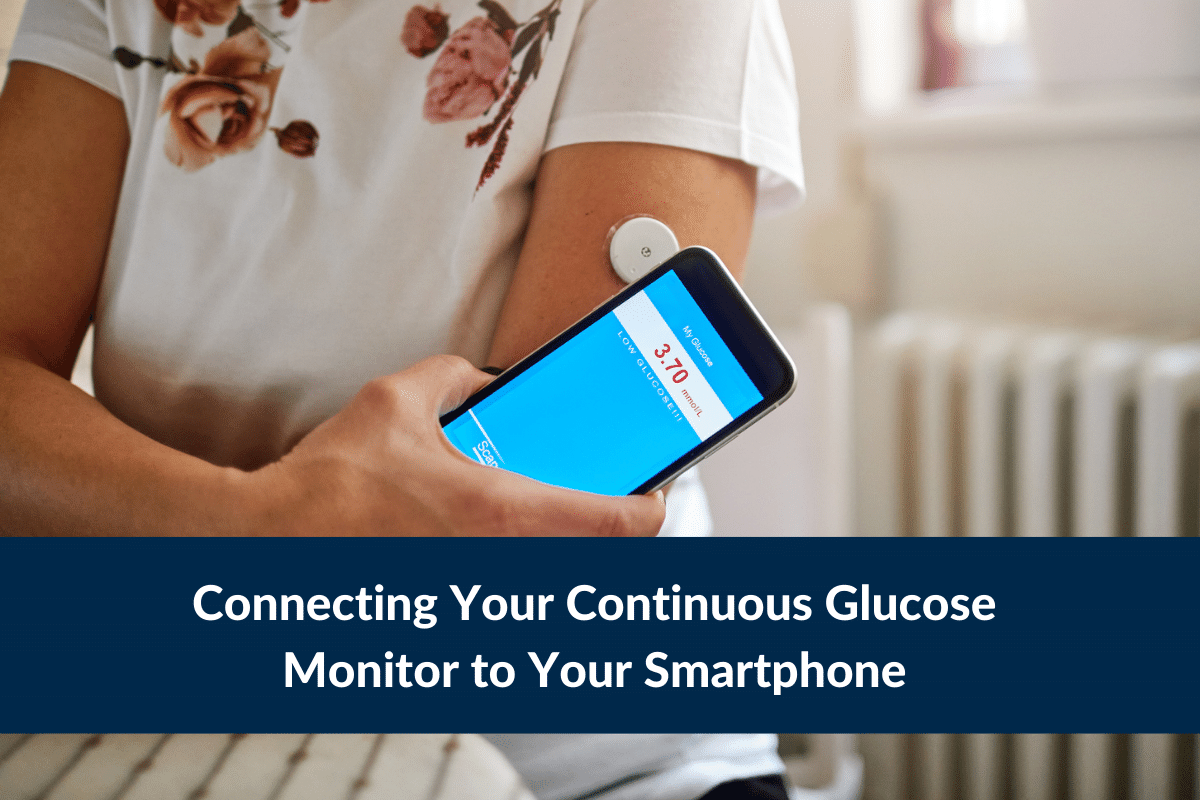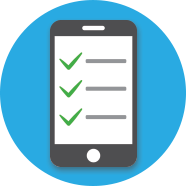Connecting Your Continuous Glucose Monitor to Your Smartphone
This post was reviewed by our Director of Clinical Excellence and Oversight.
Do you live with diabetes? If so, you’ve probably heard about, or even considered using, a Continuous Glucose Monitor. A Continuous Glucose Monitor, also known as a CGM, is a wearable device that lets you track your blood sugar without the need for frequent fingersticks.
CGM systems, including the Dexcom G6 and the FreeStyle Libre 2 14 day system have additional features that make them indispensable to people living with diabetes. For example, many have alarms that will alert you when your glucose levels are trending too high or too low, and they make it easier to share blood sugar data with a healthcare provider or family member. While some CGM systems use a dedicated receiver, all CGMs also allow users to connect the CGM with an app on their smartphone for extra convenience. This blog will help you learn more about Continuous Glucose Monitors and how they can integrate with your smartphone to help you monitor your blood glucose levels.

How CGMs Work
With 34 million Americans diagnosed with diabetes, it’s likely that you, or someone close to you has type 1 or type 2 diabetes. Managing the condition, whether type 1 or type 2, requires a multi-step process to keep your blood sugar in the range recommended by your doctor. Those steps include monitoring glucose levels, attending your doctors’ appointments, taking prescribed medications or insulin injections, getting appropriate exercise, and controlling carbohydrates through diet. It may sound like a lot, especially if you’re new to diabetes self-care.
The Dexcom G6 and Freestyle Libre 14 Day and Freestyle Libre 2 CGM systems all work to assist you in monitoring your blood glucose levels. The Dexcom G6 system has three components-a sensor, transmitter, and handheld receiver. The blood glucose readings are transmitted continuously from the sensor via the transmitter to the handheld receiver or smart phone app. The Freestyle Libre 14 Day and Freestyle Libre 2 CGM systems have two components-a sensor and handheld reader. The sensor is intermittently scanned with the reader (either handheld or smart phone app) to obtain blood glucose readings. For all devices, the sensor is placed under the skin. A waterproof adhesive patch keeps it in place, and lets you swim or shower while wearing it.
Research has found that Continuous Glucose Monitors can:
- Increase the time users are in their target glucose range.
- Reduce episodes of low blood sugar (hypoglycemia).
- Contribute to a lower A1C, a measure of blood sugar over several months.
- Have a beneficial effect on treatment satisfaction and overall wellbeing.
That’s a lot of advantages. Many users benefit even more by using their smartphones to check the latest numbers, instead of relying on the monitor. Read more about how CGMs work in CGM Devices: Everything You Need to Know.
CGMs take the place of glucose meters, test strips, and lancets, but most providers recommend having these supplies on hand in case of sensor failure or to use during the sensor warm up time.
Pairing with Your Smartphone: It’s All about the App
CGMs use apps to connect to your smartphone. Both FreeStyle Libre and Dexcom G6 offer their own app that lets you use your smartphone to check your glucose level. Once you download the app, you’ll be guided through steps to sync your compatible phone to the CGM.
FreeStyle Libre
You can find information about downloading the FreeStyle Libre apps at https://www.freestyle.abbott/us-en/products/freestyle-libre-app.html. Abbott, the maker of FreeStyle Libre, describes the process like this:
- Download the FreeStyle Libre 2 app, or FreeStyle LibreLink app
- Register on the app
- Scan the sensor
- Share readings (and, with the FreeStyle Libre 2 app), alarms
Scanning the sensor provides your latest glucose value, including a trend arrow and 8-hour historical graph showing how your glucose is reacting to food, exercise, and other factors. The device you start your sensor with is the one you must use until you replace the sensor with a new one in about 14 days.
Once you’re set up, scanning on your phone will instantly display your trend level and a graph. The app also permits you to make notes about food and exercise, factors that can impact your glucose level. For details about compatibility and setup, visit: https://www.freestyle.abbott/us-en/products/freestyle-libre-app.html. A list of devices compatible with FreeStyle Libre can be found at: https://freestyleserver.com/Payloads/IFU/2022/q1/ART41556-202_rev-C-Web.pdf.
Dexcom G6
If you are using, or plan to use, the Dexcom G6, here is the link for information about downloading the mobile apps: https://www.dexcom.com/faqs/how-to-set-up-dexcom-g6-app-with-phone. Like FreeStyle Libre, the Dexcom app walks you through the setup, including setting your low alert and high alert levels.
The home screen shows current blood glucose level and how your blood sugar level is trending, meaning whether it is rising, falling, or staying steady. You can also access a graph of blood sugar levels over time.
If you are using an insulin pump or inpen device, your sensor readings can be personalized by changing some options. You can enter units of insulin, carb grams at each meal, exercise, and other health data like stress levels, illness, alcohol consumption, and menstrual cycles. If you choose, the information can be shared with a partner or care provider. For details on the compatibility of various devices with Dexcom G6, visit www.Dexcom.com/compatibility.

Both FreeStyle Libre and Dexcom G6 offer apps that let you use your smartphone or other device to check your glucose level. Once you download the app, follow the steps to sync your phone to the CGM.
Lots to Learn. We Can Help.
Is a Continuous Glucose Monitor right for you? If so, which brand and which model will best suit your needs? Which is a better fit with your Android or iPhone device?
If you’re leaning toward a CGM, consult with your doctor or diabetes educator to ensure that you are a good candidate for the technology. Once you have a prescription, your next call should be to the CGM experts at Home Care Delivered. Call us at 866-904-0815 for important information about coverage by your insurance, Medicare, or Medicaid plan. We’ll even handle all the paperwork with your doctor and insurance provider!
Stay strong, and stay informed, as you navigate the many facets of diabetes care with the help of your healthcare team and the experts at HCD. We’re all working toward the same goal—your good health and peace of mind!
Disclaimer:
Unless otherwise noted, the recommendations in this document were obtained from the sources indicated. Be advised that information contained herein is intended to serve as a useful reference for informational purposes only. HCD cannot be held responsible for the continued accuracy of or for any errors or omissions in the information. All trademarks and registered trademarks are the property of their respective owners.
